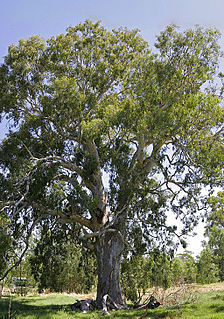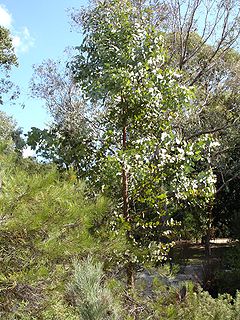
Eucalyptus regnans, known variously as mountain ash, swamp gum, or stringy gum, is a species of Eucalyptus native to Tasmania and the state of Victoria in southeastern Australia. It is the tallest flowering plant and one of the tallest trees in the world, second only to the coast redwood of North America. A straight-trunked tree with smooth grey bark, but with a stocking of rough brown bark from 5 to 20 metres above the ground, it regularly grows to 85 metres (280 ft), with the tallest living specimen, the Centurion in Tasmania, standing 100.5 metres tall. White flowers appear in autumn. Victorian botanist Ferdinand von Mueller described the species in 1871.

Pardalotes or peep-wrens are a family, Pardalotidae, of very small, brightly coloured birds native to Australia, with short tails, strong legs, and stubby blunt beaks. This family is composed of four species in one genus, Pardalotus, and several subspecies. The name derives from a Greek word meaning "spotted". The family once contained several other species now split into the family Acanthizidae.

Psyllidae, the jumping plant lice or psyllids, are a family of small plant-feeding insects that tend to be very host-specific, i.e. each plant-louse species only feeds on one plant species (monophagous) or feeds on a few closely related plants (oligophagous). Together with aphids, phylloxerans, scale insects and whiteflies, they form the group called Sternorrhyncha, which is considered to be the most "primitive" group within the true bugs (Hemiptera). They have traditionally been considered a single family, Psyllidae, but recent classifications divide the group into a total of seven families; the present restricted definition still includes more than 70 genera in the Psyllidae. Psyllid fossils have been found from the early Permian before the flowering plants evolved. The explosive diversification of the flowering plants in the Cretaceous was paralleled by a massive diversification of associated insects, and many of the morphological and metabolic characters that the flowering plants exhibit may have evolved as defenses against herbivorous insects.

The bell miner, commonly known as the bellbird, is a colonial honeyeater endemic to southeastern Australia. The common name refers to their bell-like call. "Miner" is an old alternative spelling of the word "myna" and is shared with other members of the genus Manorina. The birds feed almost exclusively on the dome-like coverings, referred to as "bell lerps", of certain psyllid bugs that feed on eucalyptus sap from the leaves. The psyllids make these bell-lerps from their own honeydew secretions in order to protect themselves from predators and the environment.

Eucalyptus camaldulensis, the river red gum, is a tree of the genus Eucalyptus. It is one of around 800 species within the genus. It is a plantation species in many parts of the world, but is native to Australia, where it has the most widespread natural distribution of Eucalyptus in Australia, especially beside inland water courses. It is named for a private estate garden near the Camaldoli monastery near Naples, from where the first specimen came to be described. Material from this tree was used by Frederick Dehnhardt, Chief Gardener at the Botanic Gardens in Naples, to describe this species in 1832.
Red Gum may refer to any of a number of species of Eucalyptus or the closely related Corymbia and Angophora, including
Eucalyptus oil is the generic name for distilled oil from the leaf of Eucalyptus, a genus of the plant family Myrtaceae native to Australia and cultivated worldwide. Eucalyptus oil has a history of wide application, as a pharmaceutical, antiseptic, repellent, flavouring, fragrance and industrial uses. The leaves of selected Eucalyptus species are steam distilled to extract eucalyptus oil.

Eucalyptus rudis, commonly known as moitch, swamp gum and flooded gum, is a tree native to Western Australia. The Noongar names for the tree are Colaille, Gooloorto, Koolert and Moitch.

Eucalyptus dumosa, commonly known as the Walkerie mallee, Congoo mallee, Cong mallee, Dumosa mallee or the White Mallee, is a mallee of south eastern Australia. Mallee is the Wergaui/ Wotjobaluk word for this species.

Eucalyptus robusta, commonly known as swamp mahogany or swamp messmate, is a tree native to eastern Australia. Growing in swampy or waterlogged soils, it is up to 30 m (98 ft) high with thick spongy reddish brown bark and dark green broad leaves, which help form a dense canopy. The white to cream flowers appear in autumn and winter. The leaves are commonly eaten by insects, and are a food item for the koala. It is an important winter-flowering species in eastern Australia, and has been planted extensively in many countries around the world. Its timber is used for firewood and in general construction.

Eucalyptus oleosa, commonly known as the red mallee, glossy-leaved red mallee, acorn mallee, oil mallee or giant mallee. is a native tree of Australia The leaves were once harvested for the production of cineole based eucalyptus oil. Eucalyptus cneorifolia is now the predominant strain used in production due to a higher oil content in new growth.

Spondyliaspidinae is a bug subfamily in the family Aphalaridae. Plant eaters, they primarily feed on eucalypts.
Cardiaspina retator is a bug species in the genus Cardiaspina, found on Eucalyptus species in Australia.

Cardiaspina fiscella, the brown basket lerp or brown lace lerp, is a jumping plant louse species in the genus Cardiaspina originally found in Australia. It spread to New Zealand where it was found in 1996 near the Auckland airport. It feeds on eucalyptus, especially swamp mahogany, and is found in Victoria, eastern New South Wales, and southeastern Queensland, as well as the capital territory (ACT) around Canberra and on Norfolk Island. Cardiaspina fiscella has five nymphal instars, and as the instars moult they add a layer to their outside covering (casing), known as the "lerp".

Eucalyptus incrassata, commonly known as the lerp mallee, yellow mallee, ridge fruited mallee or rib fruited mallee, is a mallee that is native to southern Australia.

Eucalyptus occidentalis, commonly known as the flat topped yate or the swamp yate, is a tree that is native to Western Australia. The Noongar names for the tree are Mo or Yundill.

Psyllaephagus is a genus of chalcid wasps. It was named and circumscribed by William Harris Ashmead in 1900. As of 2017, Psyllaephagus contains approximately 245 species.














